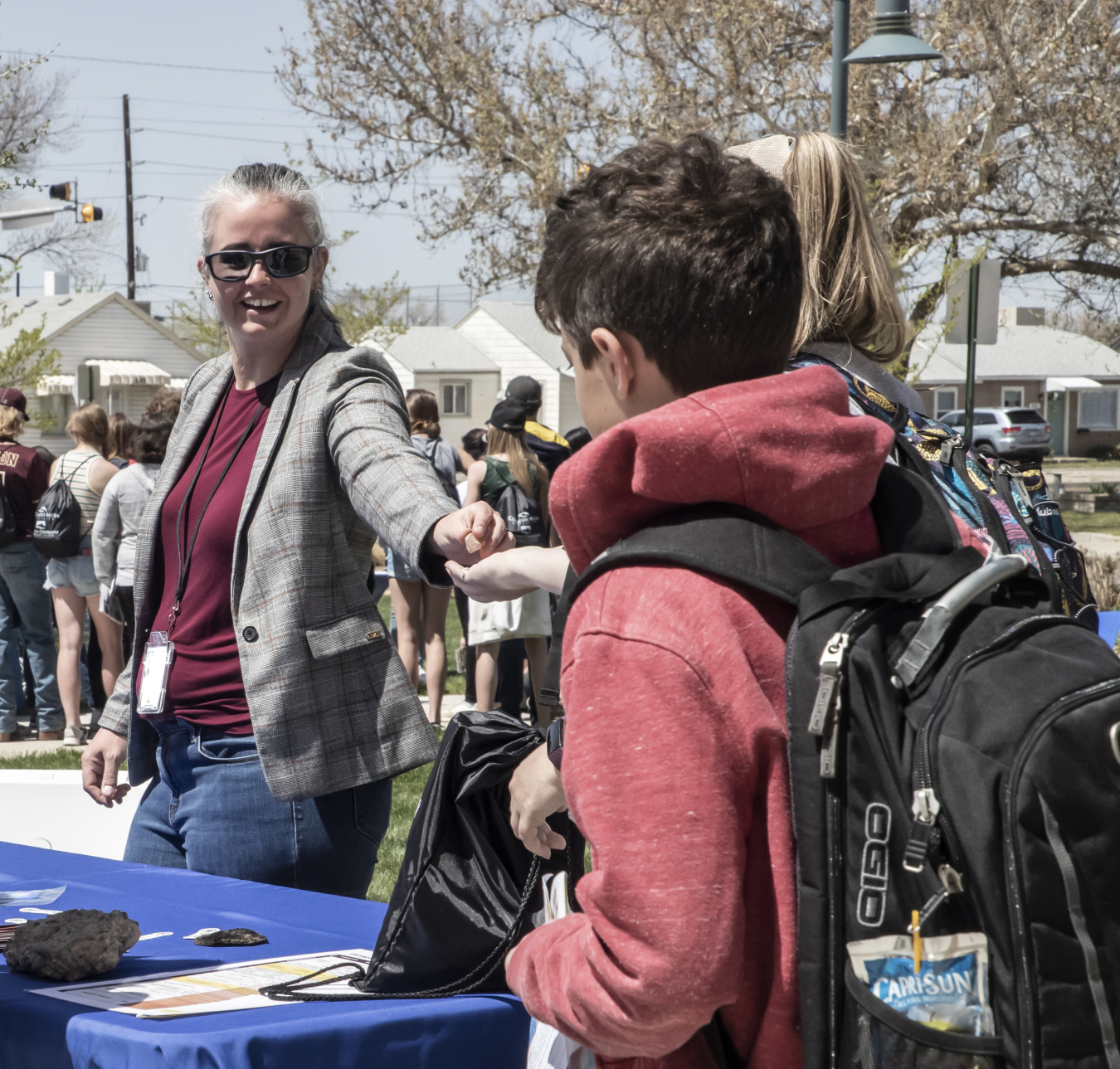Site Manager Meghann Hurt emphasizes the importance of team building and hopes to bring capstone project to fruition within LM.
April 13, 2023U.S. Department of Energy Office of Legacy Management Site Manager Meghann Hurt recently graduated from the DOE Leadership Development Program.

LM Site Manager Meghann Hurt works with students at a middle-school career fair in Grand Junction, Colorado, in April 2022. Hurt recently graduated from a U.S. Department of Energy Leadership Development Program in which she and her teammates from across DOE learned to foster new leadership and management practices by sharing group experiences and environments.
The six-month program challenges participants to adopt and foster new leadership and management practices by sharing group experiences and environments. The program creates a proactive conversation about innovation, intrapreneurship, and leadership. This continued focus drives transparency and accountability and fosters healthy conflict, resulting in increased engagement from leaders and an organization’s position for success.
Hurt, site manager for five Uranium Mill Tailings Remedial Action sites and five Nevada Offsites, joined the program to develop personally and professionally.
“It’s important to me that I bring the best version of myself to work every day, and that requires being open to learning, appreciating my strengths, and taking opportunities to better myself in areas that I may not be as strong in,” Hurt said. “It’s also a good reminder that we’re all capable of being leaders, and we frequently find ourselves in a leadership position and not even realize it. Being a leader does not mean being the boss.”
At the end of the program, participants form groups and present a capstone project, called an “Action Learning Project.” The group’s ALP demonstrates what they learned throughout the course and allows them to practice their leadership skills by working together to develop an idea for how the DOE could be helped or improved.
Hurt’s ALP group comprised DOE employees from several offices, including Environmental Management, Energy Efficiency and Renewable Energy, Science, Inspector General, and Enterprise Assessments. The group chose to focus on team building.
“Each of us, more times than we could count, were put on teams that were just ‘product-driven’ with little thought as to how we can improve our ability to work together,” Hurt said. “We focused our project on Tuckman’s Stages of Team Development: Forming, Storming, Norming, Performing, and Disbanding.”
“The goal of our ALP, using the tool kit we proposed, would be to have team-building tools for each stage of the process,” said Hurt. “These tools would include templates for meetings, setting SMART goals, articles about the different steps as well as team-building activities (collaborating with a specific outcome in mind).”
The project helped teammates learn about each other’s work styles, which resulted in the team building more trust, collaborating effectively, and being happier at work. The capstone argued that team members who feel seen, heard, empowered, and fulfilled are likelier to be a high-performing, happy team.
Hurt believes LM’s encouragement of staff development has led to LM’s success so far. LM’s high scores on the Federal Viewpoint Survey — which measures employees' perceptions of their work experiences, leadership in the workplace, and overall agency — reaffirms Hurt’s belief.
“I believe that LM’s encouragement of personal and professional growth and their desire to see people succeed have led to employees feeling validated,” Hurt said. “LM recognizes that their employees are top notch. And while our primary focus is on the mission, LM understands that with supporting the individual comes a higher chance of employee retention. People like working at LM.”
While Hurt believes LM does a great job cultivating its high-performing teams, she also believes there is always room for improvement.
“It would be great if LM could implement a dashboard similar to what our ALP was proposing,” said Hurt. “Within LM, our teams tend to remain pretty consistent and last long term; however, it doesn’t mean that we do not continually move through Tuckman’s stages of team development.”
The Tuckman model explains that as a team becomes more skilled and experienced, relationships are established, and leadership style changes to be more collaborative or shared.
“If there are tools we can easily access at various stages, it will not only help the team stay on task and mission-focused, but it will also allow us to feel more like a cohesive team instead of coworkers,” Hurt said. “Plus, I think if people had a better understanding of what the stages of team development were, they would know that the different phases and feelings they may observe are completely normal.”
Hurt is excited to bring her new skills to the workplace and home.
“There are a lot of carryovers in terms of the leadership skills you can bring to the office as well as at home,” Hurt said. “I believe that who you are as a person and how you carry yourself directly translates into what kind of coworker, supervisor, manager, mentor, etc., you are at work. I’m excited to continue to learn and grow both professionally and personally.”

